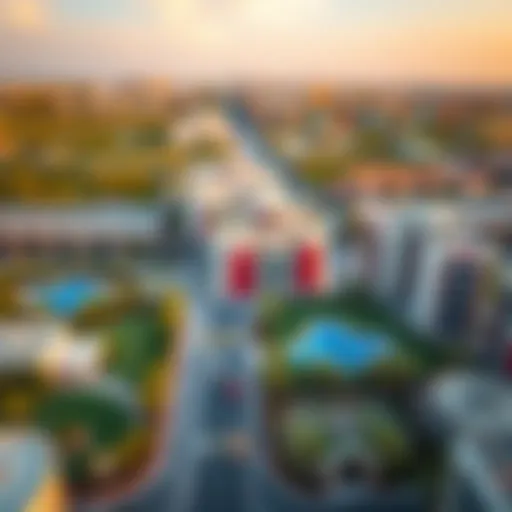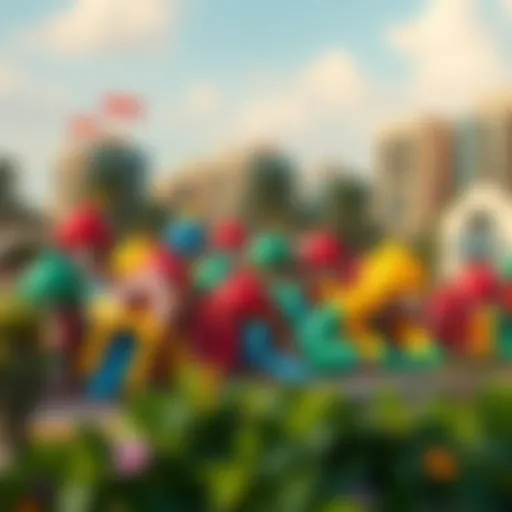Legacy of the Bin Shabib Twin Towers in Dubai
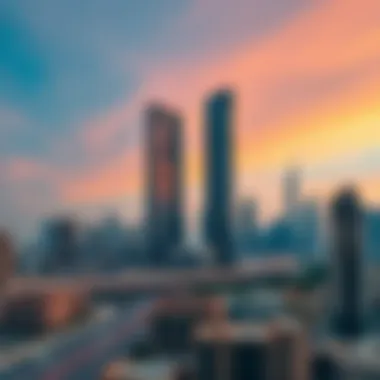
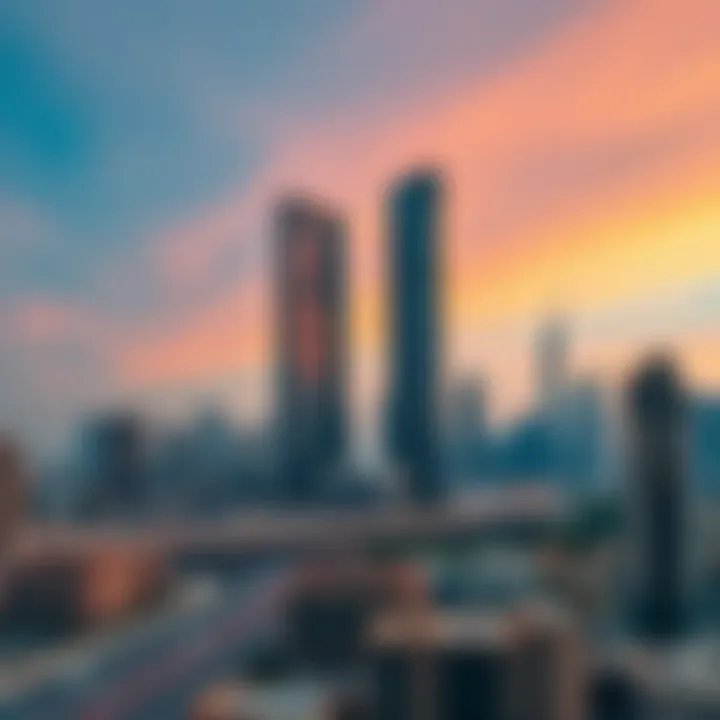
Intro
The Bin Shabib Twin Towers, standing tall against the dazzling Dubai skyline, are more than just structures of glass and steel. They echo the rich narrative of a city that has harmonized tradition with modernity. These towers are not only home to offices and commercial space but also serve as a landmark representing the urban ambition of Dubai. Within their walls lies a story of innovation, culture, and aspiration that resonates with both local and international observers.
In this exploration, we will dive into various facets of the Twin Towers. We will unpack their architectural significance, discover how they fit into the broader urban fabric of Dubai, and analyze their cultural footprint. From environmental impacts to community engagement, we aim to paint a layered picture that offers insights for urban planners, real estate developers, and residents alike.
The discourse will navigate through neighborhood features, community life, and future trajectories that these towers may take. By illuminating these aspects, hoping to foster a satisfactory understanding of how the Bin Shabib Twin Towers symbolize more than architectural prowess—they represent a way of life that is intrinsically linked to the evolving identity of Dubai.
Prelims to Bin Shabib Twin Towers
The Bin Shabib Twin Towers stand as a striking testament to Dubai's rapid growth and ambition. In a city where skyscrapers touch the clouds and innovation is the norm, these towers are more than just tall buildings. They symbolize the spirit of a metropolis that has gone from a humble fishing village to a global powerhouse in a matter of decades.
The significance of the Bin Shabib Twin Towers extends beyond their architectural prowess. These structures not only alter the skyline but also influence the very fabric of urban life in Dubai. They offer insights into the cities of the future, showcasing how modern design integrates with environmental considerations and cultural elements. By analyzing the legacy of these towers, one uncovers the story of a city in constant evolution.
The Significance of Iconic Structures in Urban Development
Iconic structures like the Bin Shabib Twin Towers play a vital role in shaping urban identity. They serve multiple functions that affect both residents and visitors alike:
- Cultural Significance: Towers often become symbols of national pride and cultural heritage. The Bin Shabib Twin Towers, for instance, reflect the ambitious vision that defines modern Dubai. Their unique architectural style fuses traditional elements with contemporary designs, promoting a sense of local identity while still appealing to international audiences.
- Economic Drivers: Structures such as these can serve as catalysts for investment. As more companies set up shop nearby, the economic benefits extend throughout the region. Increased foot traffic can breathe life into local businesses and attract new opportunities.
- Community Hubs: Iconic structures often become gathering points for communities, offering spaces for social interaction. The public areas around these towers can be designed to foster unity among diverse populations, enhancing social cohesion.
In a nutshell, the Bin Shabib Twin Towers encapsulate the aspirations of Dubai, demonstrating how architecture can influence social fabric, drive economic growth, and serve as a canvas for cultural expression. Understanding their legacy provides valuable lessons for urban planners and architects contemplating the future of their own cities.
The Historical Context
Understanding the historical context of the Bin Shabib Twin Towers is crucial for appreciating their significance in Dubai’s urban landscape. These towers are not just structures; they are a testament to the rapid transformation that Dubai has undergone over the past few decades. The intertwining of architecture and urban planning reflects larger economic and cultural narratives that have shaped the city.
Dubai's Rapid Urbanization
In the late 20th century, Dubai underwent a remarkable metamorphosis. What was once a sleepy coastal trading post has ballooned into a bustling metropolis admired worldwide. This rapid urbanization can be attributed to several factors. First off, the discovery of oil in the 1960s propelled exponential growth, attracting investments and migrants alike.
The skyline of Dubai began to change, marked by ambitious projects and innovative designs. The Bin Shabib Twin Towers emerge from this whirlwind of change, representing both a physical and symbolic manifestation of modernization. As the city sought to position itself among global cities, structures like these became essential to its identity. They feel like beacons, mirroring both ambition and cultural evolution.
The transformation wasn’t just architectural; it included social dynamics. Communities were formed, and diverse cultures blended together. The face of Dubai became a tapestry of influences, making every new building, especially iconic twin towers, a critical chapter in its evolving story.
The Genesis of Bin Shabib Twin Towers
The inception of the Bin Shabib Twin Towers traces back to a vision that combined iconic architecture with practicality. Conceived during a phase when Dubai was eager to showcase its capabilities, the towers aimed to attract international business and tourism. The idea was straightforward, yet profound: create structures that would symbolize Dubai's ambitions and offer functionality.
Serious planning involved extensive consultations with city planners, architects, and engineers. Deliberations were not just about aesthetics but also about enhancing the urban experience. There was a focus on sustainability, and the towers incorporated eco-friendly technologies long before green building became trendy.
The towers were designed to accommodate offices, residential spaces, and leisure areas, encapsulating the notion of mixed-use development. This initiative reflects a shift in urban planning philosophies, emphasizing the need for synergy in living, working, and leisure. The Bin Shabib Twin Towers stand as proof that the genesis of a building goes beyond the physical; it embodies foresight, economic strategy, and cultural resonance.
"Architecture is a silent ambassador of your values."
This quote holds true regarding the Twin Towers. They are more than just concrete and glass; they’re representations of a forward-thinking city poised to meet the challenges of an ever-evolving global landscape.
Architectural Overview
The Architectural Overview of the Bin Shabib Twin Towers serves as a fundamental layer in understanding their role within Dubai's urban fabric. These towers are not merely buildings; they stand as testaments to the intersection of cutting-edge design and cultural ethos. Their significance goes well beyond aesthetics, influencing urban planning and community interaction in the area.
Design Philosophy and Aesthetic Elements
The design philosophy behind the Twin Towers reflects a vibrant blend of modern architectural trends and local cultural nuances. The aesthetic choice emphasizes verticality, accentuated by sleek glass facades that mirror the evolving Dubai skyline. This choice is not arbitrary; it enhances light penetration into the building, making it energy-efficient while contributing to a feeling of openness.
Incorporating Islamic architectural elements, such as intricate patterns and calligraphy, the towers exhibit respect for local heritage. The use of curves and soft lines contrasts with harsh edges, creating a welcoming atmosphere. Such thoughtful details aren't just eye-catching; they forge a connection between the structures and the surrounding environment.
- Transparency: The extensive use of glass not only provides stunning views but symbolizes openness in modern-day Dubai.
- Sustainability: Elements like green terraces and balconies encourage biodiversity and provide natural insulation.
- Cultural Symbolism: The towers embody a modern interpretation of traditional Middle Eastern design principles, linking the past with the future.
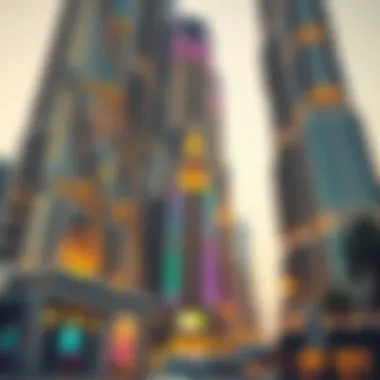
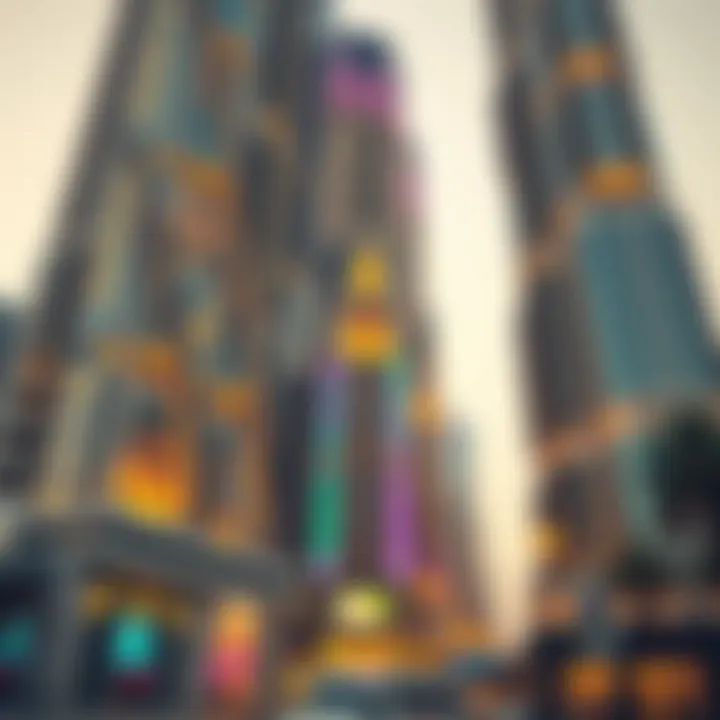
This fusion of aesthetics and functionality reveals how architecture can become a powerful narrative tool, expressing a community's identity while embracing innovation.
Engineering and Construction Techniques
The engineering achievement of the Bin Shabib Twin Towers is impressive, showcasing advanced construction techniques. Utilizing a buttressed core system, the towers enhance structural stability, allowing for heights that were previously unachievable in the region. This method is particularly relevant given Dubai's occasionally harsh weather conditions.
The construction phase incorporated rapid-build techniques, significantly reducing the timeline without compromising quality. This approach involved:
- Prefabricated Materials: Elements like precast concrete slabs were manufactured off-site, allowing for faster installation.
- Advanced Robotics: Cutting-edge technology was employed for precision in tasks such as steel reinforcement tying and concrete pouring.
- Vibration Control Systems: To ensure safety and comfort, the towers adopted systems designed to mitigate the effects of wind forces.
Through these innovative practices, the Bin Shabib Twin Towers were not only constructed to be visually striking but also to offer safety and durability, exemplifying the pinnacle of modern engineering in challenging environments.
The Bin Shabib Twin Towers illustrate how thoughtful design and robust engineering converge to create a legacy that speaks to both functionality and cultural pride, offering insights into contemporary urban development.
Cultural Significance
The Bin Shabib Twin Towers stand tall not just as physical structures in the skyline of Dubai, but they also represent a convergence of various cultural narratives and identities. This cultural significance cannot be understated; it shapes how we perceive these towers beyond their architectural prowess.
Representations of National Identity
In the heart of a city that thrives on rapid evolution, the Bin Shabib Twin Towers are a steadfast symbol of Dubai's national identity. Their silhouette serves as a canvas for the stories of the Emirati people, reflecting aspirations, heritage, and contemporary values. The towers are more than mere edifices; they encapsulate the spirit of a nation that is both rooted in history yet ambitiously forward-looking.
The intricate design elements echo traditional Arabic architecture while embracing modern materials and technology. This juxtaposition creates a visual dialogue that resonates with local inhabitants and visitors alike. For instance, the use of shading fins and patterned glass gives a nod to the patterns found in Islamic art, connecting the present with the past.
Moreover, the towers’ significance reaches into the everyday lives of the citizens, becoming a backdrop for national celebrations, festivities, and profound societal shifts. They are frequently featured in media and promotional campaigns that highlight what it means to be Emirati, reinforcing a collective identity within a diverse population.
Role in Promoting Cultural Exchange
The Bin Shabib Twin Towers act as a hub for cultural exchange, fostering interactions that go beyond borders. Their strategic location makes them a meeting point for various cultural aspects — from business to leisure, from local traditions to global influences. The towers host numerous exhibitions, events, and gatherings that encourage dialogue among different cultures, allowing for knowledge sharing and artistic collaboration.
In a city bustling with expatriates and tourists, the twin towers embody a unique blend of cultures. Art shows and community events held here often celebrate both local and international artists, bridging gaps and promoting understanding. For instance, local art exhibitions presented side by side with international pieces create a rich tapestry that showcases the evolving cultural narrative of Dubai.
By facilitating such interactions, the towers not only enhance social cohesion but also contribute to the overall cultural vibrancy of the city. They transform a mundane visit into an opportunity for deep engagement with the diverse hues of artistic expression across the globe, ultimately leading to mutual respect and appreciation.
Through their design and purposes, the Bin Shabib Twin Towers become more than buildings; they are a reflection of the Emirati identity and a platform for global cultural exchange.
For further insights on Dubai's cultural landmarks, visit Britannica or check Wikipedia for more on the city’s identity.
Sustainability and Environmental Impact
Sustainability and environmental impact are crucial topics when it comes to understanding the Bin Shabib Twin Towers. As the towers stand tall, they not only symbolize luxury and modernity but also reflect a commitment to responsible development in an age where ecological awareness is paramount. In a bustling city like Dubai, where construction goes ahead at breakneck speed, it’s vital to evaluate how these structures contribute to a sustainable urban environment. By focusing on specific green initiatives, we can appreciate the tangible benefits provided by the towers and their long-term strategic implications for the surrounding community.
Green Building Initiatives
Examining the Bin Shabib Twin Towers showcases several important green building initiatives that are not just about building tall; they’re about building right. For instance, the towers incorporate energy-efficient systems that minimize waste while maximizing utility. This includes the use of energy-saving lighting throughout the premises, which not only reduces the carbon footprint but also lowers energy costs.
Additionally, the towers utilize state-of-the-art cooling technology. Given Dubai's harsh climate, having an efficient cooling system is essential. The towers are equipped with smart ventilation systems that optimize air circulation, thereby reducing reliance on air conditioning. This implies that the buildings have conformed to the principles of sustainable architecture, ultimately enabling residents and businesses to thrive without harming the environment.
Moreover, the integration of green spaces within and around the towers promotes biodiversity. Roof gardens and planted terraces not only enhance aesthetic value but also help in improving air quality, providing a welcoming habitat for local wildlife. What this means is that sustainability and livability can go hand-in-hand.
Long-term Environmental Considerations
When we consider the long-term environmental impact of the Bin Shabib Twin Towers, the conversation extends beyond immediate benefits. For one, these towers are built to endure. The choice of durable materials ensures fewer repairs and replacements, ultimately leading to lower waste generation over decades. The long-term vision here is twofold: safeguarding resources while also providing a robust structure that meets the challenges of time.
Ongoing sustainability efforts include plans for renewable energy sources in the future. Given the rapid advancements in solar technology, incorporating solar panels on rooftops of the twin towers could provide power directly from the sun, driving down operational costs while reinforcing the building's green credentials.
Furthermore, engaging the community through various programs focused on sustainability fosters a culture of environmental awareness. Educational events and workshops can empower citizens to adopt eco-friendly practices in their daily lives, enhancing the overall sustainability of the urban ecosystem.
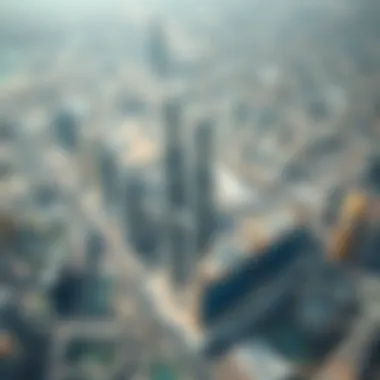
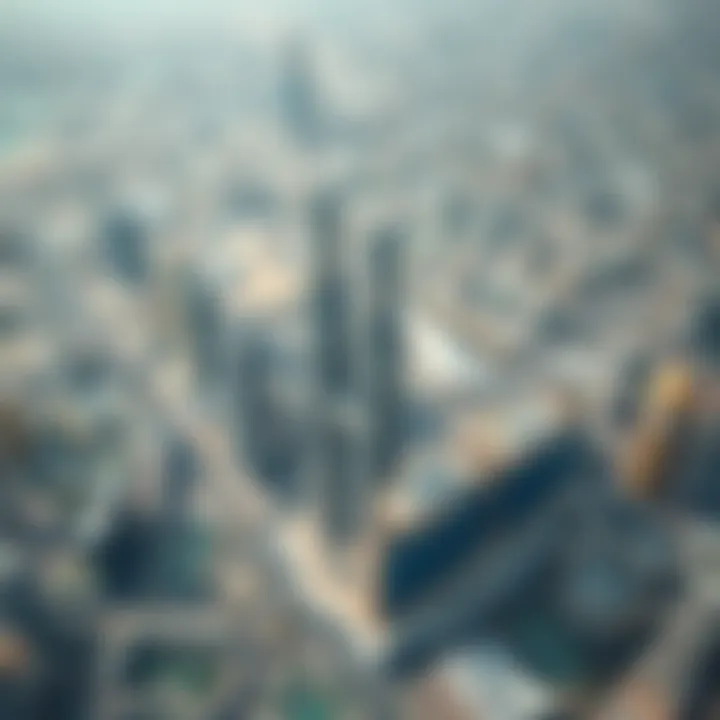
"Sustainability is no longer an option; it is a necessity that guides urban planning and development."
The Towers and Community Interaction
The Bin Shabib Twin Towers are not simply towering structures that pierce the Dubai skyline; they symbolize a hub for social interaction and engagement within the community. Their design and location have created an environment where residents and visitors can come together, fostering a sense of belonging and connection. In a city renowned for its modernity and rapid development, these towers play a pivotal role in transforming urban experiences, making them a focal point of community life.
Social Spaces and Amenities
One of the most significant aspects of the Bin Shabib Twin Towers is their emphasis on social spaces and amenities that cater to various segments of the population. The ground floor often buzzes with activity, featuring cafes, restaurants, and shops, providing a convenient meeting point for friends, families, and colleagues alike. The landscaping around the towers has been thoughtfully designed, with parks and open areas that invite people to relax, socialize, or engage in recreational activities.
- Community Gatherings: The green spaces offer venues for community gatherings, festivities, and temporary markets, which promote local culture and interactions.
- Fitness Opportunities: Gyms and wellness centers within or near the towers encourage healthy lifestyles, providing residents with the amenities necessary to maintain physical fitness.
- Cultural Activities: The towers often host art exhibitions and pop-up markets, inviting local artists and vendors to showcase their work, thus enriching community life.
The mingling of various facilities ensures that the towers are not just residential or commercial spaces, but rather dynamic ecosystems where social interactions can thrive. The availability of diverse amenities allows for a sense of convenience and accessibility, ensuring that the community feels connected to the very fabric of the towers.
Events and Community Engagement
Events held at the Bin Shabib Twin Towers are essential in nurturing community spirit. From seasonal festivals to art exhibitions and educational workshops, these gatherings provide numerous opportunities for residents and visitors to unite over shared interests. The towers often serve as a backdrop for cultural celebrations that highlight the diverse heritages of Dubai’s populace.
“Community is not just about living close, it’s about being connected.”
Community engagement through events might include the following:
- Cultural Festivals: Celebrating local customs and traditions, they promote understanding and foster collective identity.
- Workshops and Seminars: Engaging discussions on topics like sustainability or urban living encourage intellectual interaction among attendees.
- Networking Events: Opportunities for local businesses and entrepreneurs to showcase their offerings, helping to boost the local economy.
- Charity Drives: Collaborations with non-profits to support local causes, strengthening bonds within the community.
These events not only enliven the community but also contribute to the economic vitality of the area. With each gathering, the Twin Towers become not merely residential landmarks, but valuable parts of the social infrastructure in Dubai. As people gather to celebrate, learn, and connect, they are fostering a culture of inclusivity that is essential to the city's growth and harmony.
In closing, the interaction between the Bin Shabib Twin Towers and the community they serve is not just a byproduct of their mere existence. It is a heartfelt commitment to enhance and enrich lives, drawing people together in ways that celebrate diversity and promote unity in this ever-evolving urban landscape.
Influence on Real Estate Market
The Bin Shabib Twin Towers serve as more than just a notable architectural achievement; their impact on the real estate landscape in Dubai is profound. As towering symbols of innovation and luxury, they have solidified Dubai's foray into becoming a global real estate powerhouse. The sight of these skyscrapers draws attention, signaling the city's robust growth and its potential as a lucrative real estate investment destination.
The importance of the Twin Towers extends beyond their physical presence; they contribute significantly to the dynamics of supply and demand within the market. Particularly, their high-profile location and striking design have made them attractive options for both residential and commercial stakeholders. Investors eyeing opportunities in Dubai's real estate arena are often keen to associate their ventures with these iconic structures due to their perceived value and prestige.
Market Dynamics Around the Towers
When we talk about the market dynamics around the Bin Shabib Twin Towers, it’s clear that several factors intertwine—location, pricing, and the type of amenities offered. The towers anchor an area known for its bustling business environment, making nearby properties attractive. They cater to a demographic that seeks both luxury and convenience, which can be a game-changer in attracting investment.
Some notable aspects of the market dynamics include:
- Increased demand for premium residences: Those looking for high-end apartments often choose units in proximity to landmarks like the Twin Towers, thus driving up real estate prices.
- Business appeal: The vicinity of these towers attracts multinational companies wanting office spaces, further influencing leasing prices and terms.
- Real estate fluctuations: The presence of such iconic architecture often stabilizes the area’s real estate market, buffering it against downturns, as properties around high-profile locations tend to retain value better than those in less notable areas.
This balance creates a ripple effect, prompting developers to construct more high-end facilities, ensuring that the real estate around the Twin Towers remains competitive and desirable.
Investor Perspectives
For potential investors, the Bin Shabib Twin Towers hold a magnetism that is hard to resist. They are not just structures; they are testimonies to Dubai's ambition and its sprawling economic landscape. Investors are certainly motivated to engage with properties near these towers for various reasons:
- Brand association: Owning a property near the Twin Towers is often seen as a badge of honor; it’s about being part of a prestigious area that enhances one's portfolio.
- High rental yields: The demand driven by both residents and businesses ensures that real estate near the Twin Towers yields higher returns. Rental prices in this part of Dubai see a trend of consistent appreciation.
- Cultural significance: Potential buyers are becoming increasingly aware of how cultural and architectural significance leads to sustained interest in real estate.
- Scalability: Investors appreciate that the surrounding infrastructure is improved continually, be it through transport links or community amenities, which can elevate property values further down the line.
"The Bin Shabib Twin Towers stand not only as buildings but as landmarks that excite investor imaginations, embodying the best of what Dubai real estate has to offer."
In summary, the Bin Shabib Twin Towers act as cornerstones within the intricate puzzle of Dubai’s real estate market. Their influence is multifaceted, prompting lucrative investments and sustained interest that keeps revitalizing the community around them.
Comparison with Other Iconic Structures
In the ever-changing urban narrative of cities globally, iconic structures often serve as reference points that define the skyline and character of a place. The Bin Shabib Twin Towers in Dubai are no exception. This section aims to compare them with other iconic structures around the world, emphasizing how they fit into the larger tapestry of architectural significance and community identity.
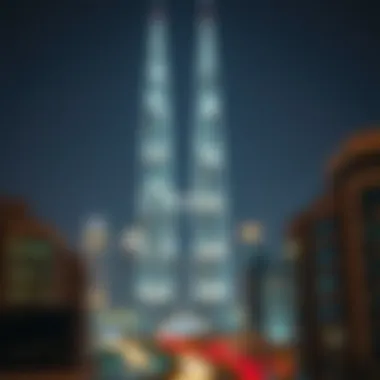
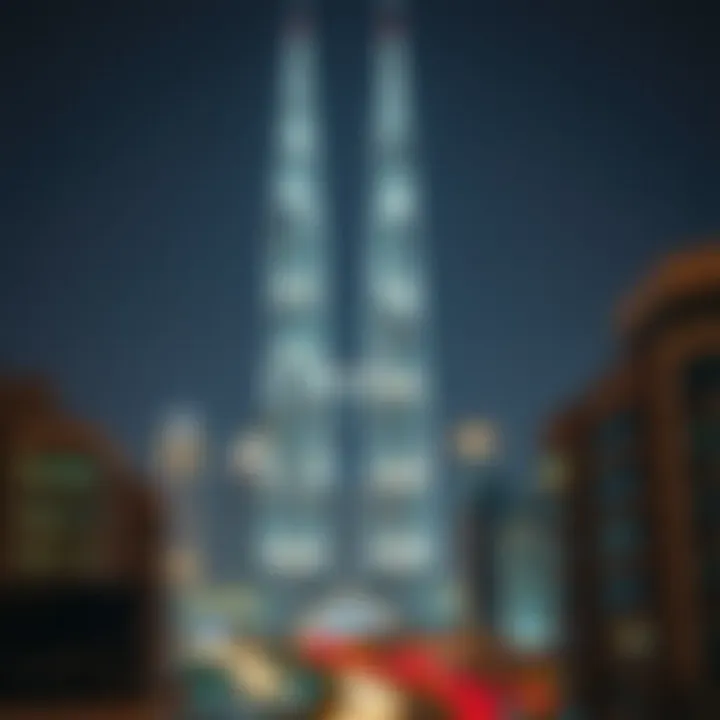
Similarities with Global Landmarks
When you take a close look at structures like the Burj Khalifa in Dubai or the Empire State Building in New York, there's more than just height that connects them. First off, both the Burj Khalifa and the Bin Shabib Twin Towers showcase the advancement of architectural design and engineering. They are built with a stainless steel exterior, echoing the hustle and bustle of Dubai while also reflecting the traditions of Islamic architecture.
Among their shared traits:
- Verticality: Like many major international landmarks, the towers' design for height symbolizes growth and ambition. Both aim at reshaping their locales and establishing benchmarks for future developments.
- Cultural Significance: Much like the Sydney Opera House or the Eiffel Tower, these structures are not only functional but also serve as cultural icons that tell a story about the city.
- Public Engagement: Just as the Louvre Pyramid invites people into the artistic heart of Paris, the Bin Shabib Towers engage the community through various amenities—gyms, cafes, and malls—allowing residents and tourists alike to connect.
This interplay of style and function mirrors what has been accomplished globally, putting the Bin Shabib Twin Towers firmly on the world stage. Through their striking similarities with these landmarks, the towers portray Dubai’s unique narrative while simultaneously belonging to an elite architectural pedigree.
Contrasts in Design and Purpose
While there are threads of similarity, it is equally important to highlight the areas where the Bin Shabib Twin Towers diverge. One major element lies in their intended purpose. For example, the Sagrada Familia in Barcelona serves as a religious site and a masterpiece in progress, while the Bin Shabib Twin Towers cater to the commercial sector, acting as hubs for business and modern living.
Differences to note include:
- Design Aesthetic: While the grandeur of the Burj Khalifa aims at shimmering upward thrust, the Bin Shabib architecture reflects a more modernist approach, integrating local cultural motifs subtly rather than as overt symbols.
- Community Integration: Unlike the isolated grandeur of structures such as Machu Picchu, the Bin Shabib Towers are designed to blend into their neighborhood, fostering a sense of community engagement. This sense of accessibility contrasts sharply with more solitary global landmarks, which can feel distant or uninvolved with their surroundings.
- Sustainability Features: Many famous buildings focus primarily on ostentation. In contrast, the Bin Shabib Towers integrate sustainable practices like energy-efficient systems, showcasing a forward-thinking vision that aligns with global environmental trends.
This dance of similarity and contrast paints a comprehensive picture of how the Bin Shabib Twin Towers hold their own in a world filled with iconic structures. Each comparison lays bare unique attributes that allow these towers not just to coexist but to flourish within the context of Dubai's evolving identity.
"Iconic structures are like the DNA of a city; they tell what we value, what we aspire to, and how we envision our future."
For an extended exploration of architectural wonders, consider visiting ArchDaily or Dezeen.
Future Prospects and Developments
In considering the legacy of the Bin Shabib Twin Towers, it's essential to reflect on their future. This discussion on future prospects and developments isn't just about bricks and mortar, but rather how these structures will continue to influence Dubai's architectural landscape, urban life, and environmental strategies. With the city constantly evolving, the towers' ability to adapt to market demands and technological advancements will shed light on the ongoing relevance of iconic structures in urban settings.
Potential Renovations and Upgrades
When it comes to renovations and upgrades, the Bin Shabib Twin Towers are ripe for thoughtful enhancement. The integration of smart technologies is becoming increasingly prevalent in urban planning, and these towers could serve as a benchmark for modern adaptations. Imagine integrating energy-efficient systems, smart lighting, and automated climate control technologies into the existing design. Not only would this elevate the towers' energy efficiency, but it would also attract a newer, tech-savvy demographic that values sustainability.
- Smart Home Technologies: Transforming individual units to include smart thermostats, security systems, and remote-controlled features could greatly improve the homeowner experience.
- Enhanced Green Spaces: Renovating the surrounding outdoor spaces to include vertical gardens and energy-producing vegetation could amplify the aesthetic and ecological value of the towers.
- Accessibility Upgrades: Incorporating modern accessibility features will ensure that all community members can enjoy the facilities, emphasizing inclusivity.
These potential upgrades would not only enhance functionality but could also boost property values, making a significant impact on the real estate market surrounding the towers. The challenge, however, is balancing historical value with modern demands—finding that sweet spot is key to ensuring their legacy continues in the face of change.
Long-term Vision for the Area
Looking ahead, the long-term vision for the area surrounding the Bin Shabib Twin Towers is multifaceted. Urban planners envision a vibrant community that thrives not only on the commercial benefits of these towers but also on their ability to foster social interactions and cultural exchanges.
This vision includes:
- Integrated Transport Solutions: Enhancing public transportation connectivity to streamline accessibility and encourage foot traffic.
- Mixed-Use Developments: Encouraging the development of retail spaces, cafes, and recreational areas that complement the residential aspects of the towers.
- Cultural Events and Festivals: Establishing calendars for events to celebrate local culture and encourage community interaction, turning the area into a hub of activity.
Moreover, efforts to establish the Bin Shabib Twin Towers as a cultural landmark will help in positioning them as not just architectural wonders but also as vital components of Dubai's identity. As these plans unfold, it's vital they align with the principles of sustainability, ensuring that growth doesn't come at the expense of the environment.
"The future is not something we enter. The future is something we create." — Leonard I. Sweet
By focusing on thoughtful renovations and a comprehensive long-term vision, there is a significant opportunity to strengthen the legacy of the Bin Shabib Twin Towers, ensuring they remain an integral part of Dubai's skyline and community for generations to come.
The End
Reflecting on the impact of the Bin Shabib Twin Towers offers a multi-dimensional perspective on how architectural landmarks can redefine urban landscapes while weaving together community, culture, and commerce. These towers stand not merely as structures of steel and glass but serve as beacons of progress, highlighting Dubai's aspirations and its role as a global city.
Reflecting on the Impact
The significance of the Bin Shabib Twin Towers lies in their embodiment of the rapid evolution of Dubai itself. They manifest the delicate balance between modernity and tradition, which defines the Emirate's character. Over the years, these towers have become much more than just a set of office buildings. They serve as social hubs, fostering a sense of community through various amenities and shared spaces.
They also represent a shift in architectural trends, marked by innovative design and environmental considerations. Notably, their sustainability initiatives pave the way for future developments in the region, showcasing how modern architecture can address climate concerns while maintaining aesthetic appeal.
In examining the long-term implications of the towers, one must consider their role in promoting investment and stimulating the local economy. The surrounding area has seen a surge in real estate activity, inspired by the presence of these iconic structures. As a result, the Bin Shabib Twin Towers have become vital in energizing the market dynamics, luring both local and foreign investors.
Ultimately, the Bin Shabib Twin Towers serve as reminders that architecture is never just about buildings; it's about the people and stories that inhabit them. They are not just places of work but are crucial in shaping how residents and visitors engage with their environment. They stand at the intersection of the past and the future, encouraging us to reflect on the impact of design in cultivating a thriving urban ecosystem.







